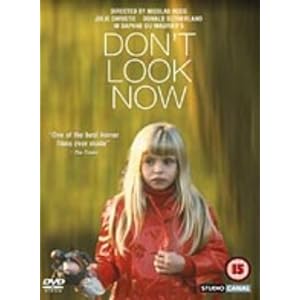
Fig 1
“Nothing is what it seems,” says John Baxter (Donald Sutherland) to his wife Laura in the opening sequence to “Don’t look Now” in response to her revelation that a pond’s watery surface is curved rather than flat.
Fig 2
 Moments later, as John examines a photographic slide that shows a red-clad figure seated in a Venetian church interior, he will spill red wine across the image – while outside the house, his young daughter Christine, dressed in a bright red mackintosh, will accidentally slip into a pond and drown (Fig2). In this chronicle of a death foretold, John has just experienced a premonition – although of what, exactly, will not be fully comprehensible until the end.
Moments later, as John examines a photographic slide that shows a red-clad figure seated in a Venetian church interior, he will spill red wine across the image – while outside the house, his young daughter Christine, dressed in a bright red mackintosh, will accidentally slip into a pond and drown (Fig2). In this chronicle of a death foretold, John has just experienced a premonition – although of what, exactly, will not be fully comprehensible until the end.John rushes out and plucks his now dead daughter from the water – and the film cuts to
This is only one of many jarring, at time violent cuts in Don’t Look Now. Nic Roeg exposes a more irrational kind of narrative continuum. Flashbacks, flashforwards, and a suggestive series of recurrent images allow both the Baxters’ past tragedy and their future destiny to infect what we see in the film’s present.
The Baxters are now in
Fig 3
 John remains skeptical of the eccentric English women’s ‘gift’ – but, increasingly lost in the city’s backstreets, he keeps catching glimpses of Christine’s distinctive blood-hued coat in the distance, as well as seeing Laura on a boat with the sisters.
John remains skeptical of the eccentric English women’s ‘gift’ – but, increasingly lost in the city’s backstreets, he keeps catching glimpses of Christine’s distinctive blood-hued coat in the distance, as well as seeing Laura on a boat with the sisters. Croce describes the almost haunting streets of Venice here with “Roeg uses Daphne Du
Maurier’s short story as a masterly procession of uncanny set-pieces, with the colour red materializing
variously as Poe’s Masque of Death, a tiny Red Riding Hood figure scuttling in dark hallways, a blot spreading malevolently over a photograph.” (Croce) Fernando F. Croce depicts the streets almost like a series of haunted hallways. With the sets de-saturated and dreary colour scheme, red primarily stands out as a prominent colour, alerting the audience.
Confused and paranoid, he turns to the Venetian police who, suspecting a link to several local murders, have John followed. Nothing, however, can make John change course as, Oedipus-like, he ignores the words of a blind seer and rushes inexorably towards a fate that he cannot properly understand.
It is easy to see how and why Don’t Look Now, adapted from the 1971 novella of the same name by Daphne Du Maurier, has not only earned but retained its reputation as a
Rather than resorting to the cheap trickery of SFX to convey the supernatural, Roeg turns to the more classical filmmaking technique of montage, evoking all manner of eerie associations through intelligent editing alone, and leaving it to the viewer to find their way through his maze of images – much as John must retrace his steps through the claustrophobic labyrinth of alleyways, bridges and canals. The eerie atmosphere also lends itself to the film as noted by Nickolas Roeg. “It works remorselessly toward a sense of dislocation in time; an undermining of all the senses, in fact, perfectly exemplified by Sutherland's marvelous Hitchcockian walk through a dark alley where a banging shutter, a hoarse cry, a light extinguished at a window, all recur as in a dream.” (Roeg, 2011) In this description, he implies that these reoccur throughout the film to evoke a sense of dislocation. Although it can somewhat throw the less experienced of the audience off, it adds to the film’s constant dash between scenes of their past, present and future in order to unnerve the audience, further adding to the atmosphere.
The shock of this film’s climax – expressed in an explosion of cuts that links virtually every scene of the film together – is one that John, and the viewer too, should have seen coming. All the signs have been there all along, as evident as they are irrational, but they are readable only with the second sight furnished by retrospect.
Bibliography:
http://www.timeout.com/film/reviews/65675/dont_look_now.html
http://www.cinepassion.org/Reviews/d/DontLookNow.html
Images:
Fig 1 http://ecx.images-amazon.com/images/I/416G0447QHL._SL500_AA300_.jpg
Fig 2 http://cinemasights.files.wordpress.com/2011/10/dontlooknow-opening.jpg
Fig 3 http://4.bp.blogspot.com/_lVsR7e8VsvM/TIaY5YOy_fI/AAAAAAAAZZk/_ApIiZMgE8w/s1600/Don't+Look+Now.jpg

This comment has been removed by the author.
ReplyDelete